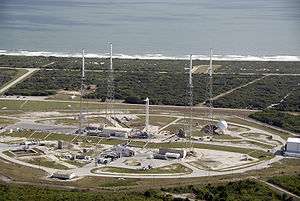- Cape Canaveral Air Force Station Space Launch Complex 40
-
Coordinates: 28°33′44″N 80°34′38″W / 28.562106°N 80.577180°W
Space Launch Complex 40 
SLC-40 in late 2009, by which point most conversion work to support the Falcon 9 had been completedLaunch site Cape Canaveral Air Force Station Location 28° 33' 44" N
80° 34' 38" WShort name SLC-40 Operator US Air Force Total launches 56 Launch pad(s) 1 Minimum / maximum
orbital inclination28°–57° Launch history Status Active First launch Titan IIIC, 18 June 1965 Last launch Falcon 9/Dragon C1
8 December 2010Associated rockets Titan III
Titan 34D
Titan IV
Falcon 9Cape Canaveral Air Force Station Space Launch Complex 40[1][2] (SLC-40), previously Launch Complex 40 (LC-40) is a launch pad at the north end of Cape Canaveral, Florida. It was used by the United States Air Force for Titan III and Titan IV launches between 1965 and 2005.
On April 25, 2007, the US Air Force leased the complex to SpaceX to launch the Falcon 9 rocket.[3]
Contents
Titan
The first launch from LC-40 was the maiden flight of the Titan IIIC (June 18, 1965), carrying two transtage upper stages to test the functionality of the vehicle.
Two interplanetary missions were launched from the pad:
- The failed Mars Observer spacecraft (September 25, 1992)
- The Cassini–Huygens mission to Saturn (October 15, 1997)
The final Titan launch from SLC-40 was the Lacrosse-5 reconnaissance satellite (Titan IV-B, April 30, 2005).
The tower was disassembled during late 2007 and early 2008. Demolition of the Mobile Service Structure (MSS), by means of a controlled explosion, occurred on April 27, 2008, by Controlled Demolition, Inc.[4]
Falcon
During April 2008, construction started on the ground facilities necessary to support the launch of the SpaceX Falcon 9 rocket. Renovations include installation of new liquid oxygen and kerosene tanks and construction of a hangar for rocket and payload preparation.
The first Falcon 9 rocket arrived at SLC-40 in late 2008, and was erected for the first time on January 10, 2009.[5] It successfully reached orbit on its maiden launch on June 4, 2010.
SLC-40 will become the launch facility of the SpaceX Dragon, a reusable automated cargo vehicle which will replace the cargo capabilities of the Space Shuttle following its retirement in 2011.[6] SpaceX successfully launched the first test flight for the Dragon from SLC-40 on December 8, 2010.
Commercial crew upgrades
In October 2009, NASA provided a pre-solicitation notice regarding an effort to be funded under the American Recovery and Reinvestment Act of 2009. The commercial crew enabling work would include a "base task" of refurbishing and reactivating SLC-40 power transfer switches, performing maintenance on the lower Aerospace Ground Equipment (AGE) substation and motor control centers, installing bollards around piping, replacing the door frame and threshold for the Falcon Support Building mechanical room and repairing fencing around the complex perimeter. Several optional tasks would include work installing conductive flooring in the Hangar Hypergol area, performing corrosion control inspection and maintenance of the lightning protection tower's structural steel, upgrading and refurbishing other facility equipment and performing corrosion control on rail cars and pad lighting poles, painting several buildings, repairing and improving roads, and hydro-seeding the complex.[7]
References
- ^ McDowell, Jonathan (1998-02-22). "Issue 350". Jonathan's Space Report. Jonathan's Space Page. http://planet4589.org/space/jsr/back/news.350. Retrieved 2009-07-09.
- ^ Table 3
- ^ Kelly, John (April 25, 2007). "SpaceX cleared for Cape launches". Florida Today. Archived from the original on September 30, 2007. http://web.archive.org/web/20070930030616/http://www.floridatoday.com/floridatoday/blogs/spaceteam/2007/04/spacex-cleared-for-cape-launches.html. Retrieved June 5, 2010.
- ^ Hidalgo Whitesides, Loretta (May 1, 2008). "Launch Pad Demolition Clears Way for SpaceX Rockets". Wired. http://blog.wired.com/wiredscience/2008/05/launch-pad-demo.html. Retrieved June 5, 2010.
- ^ Shanklin, Emily (January 12, 2009). "SpaceX's Falcon 9 on Launch Pad at Cape Canaveral". SpaceX.com. http://www.spacex.com/press.php?page=20090112. Retrieved June 5, 2010.
- ^ "NASA Selects SpaceX's Falcon 9 Booster and Dragon Spacecraft for Cargo Resupply Services to the International Space Station". SpaceX.com. December 23, 2008. http://www.spacex.com/press.php?page=20081223. Retrieved January 26, 2009.
- ^ "Recovery Act: NASA Solicitation: Commercial Crew Enabling Initiative – Upgrades to Launch Complex 40". SpaceRef Interactive. October 27, 2009. http://www.spaceref.com/news/viewsr.html?pid=32678.
Cape Canaveral and Merritt Island launch sites Atlantic Missile Range drop zone • Grand Turk Island drop zone • Mobile Launch Area • SLBM Launch Area • Patrick AFB • Shuttle Landing Facility • Cape Canaveral AFS Skid StripSpaceX Vehicles Engines Launch Sites Missions Falcon 1Falcon 9Falcon HeavyFlight 1 (2013)Dragon/COTSContracts Categories:- Buildings and structures in Brevard County, Florida
- Cape Canaveral Air Force Station
- SpaceX
Wikimedia Foundation. 2010.

